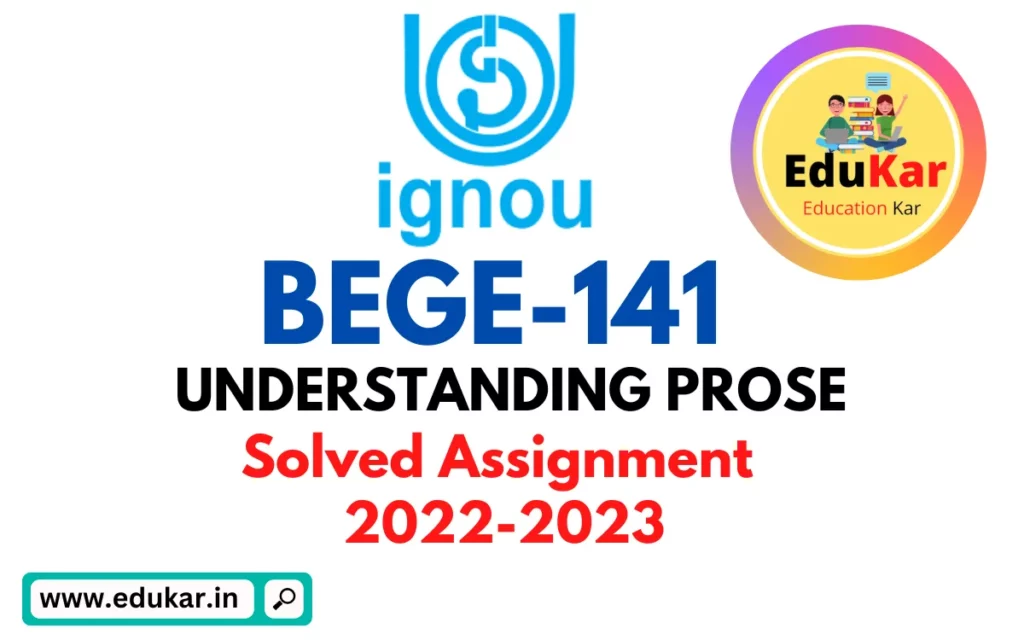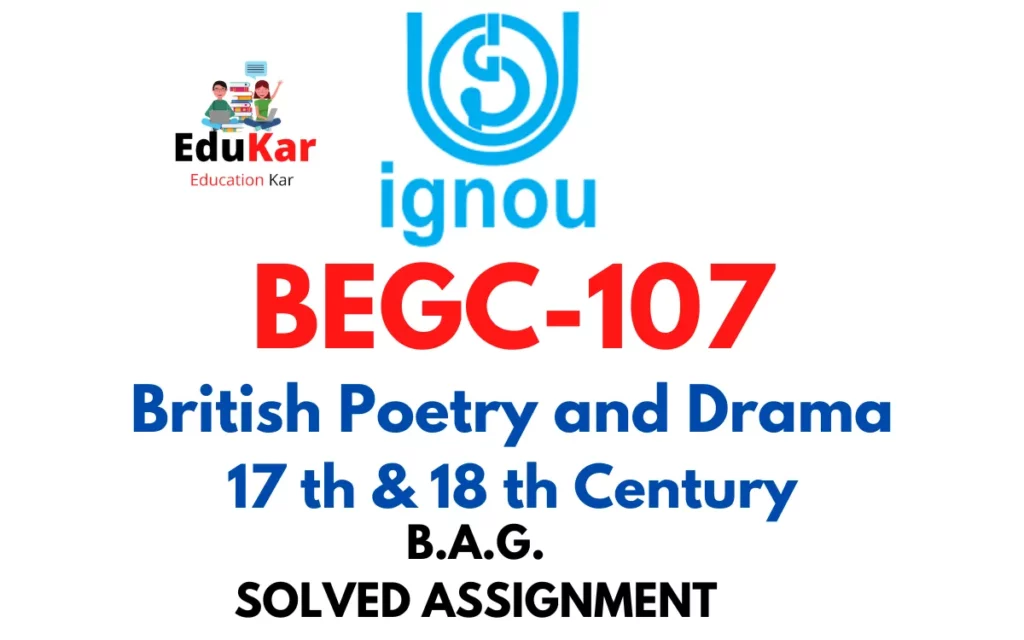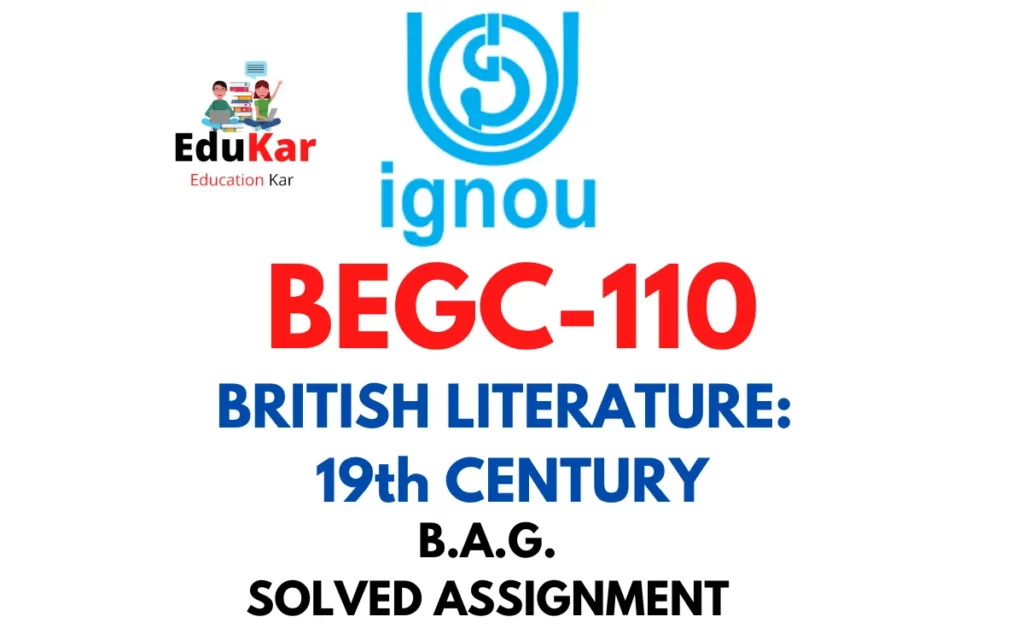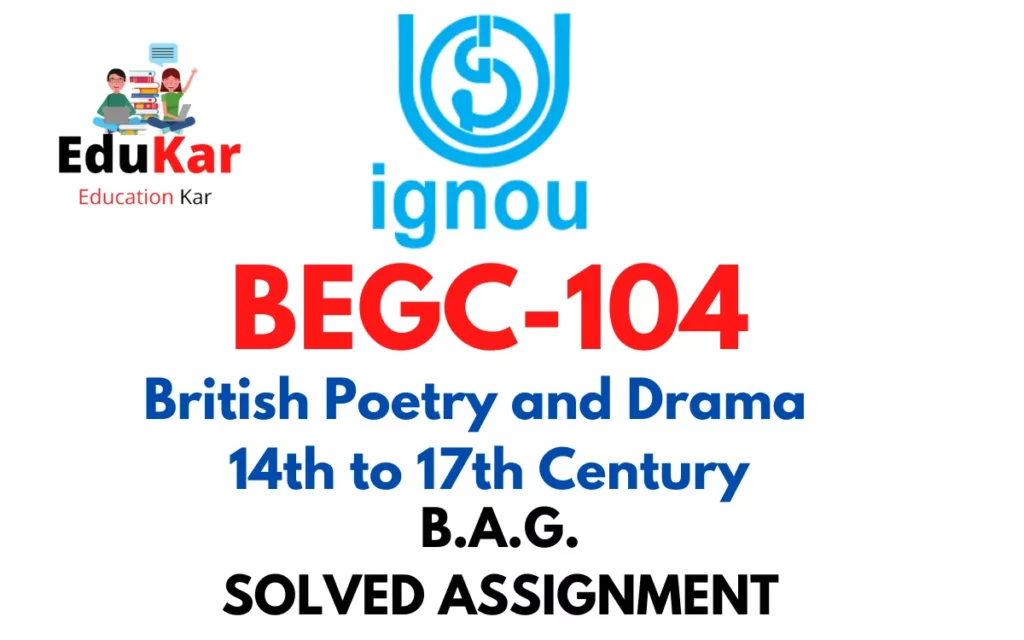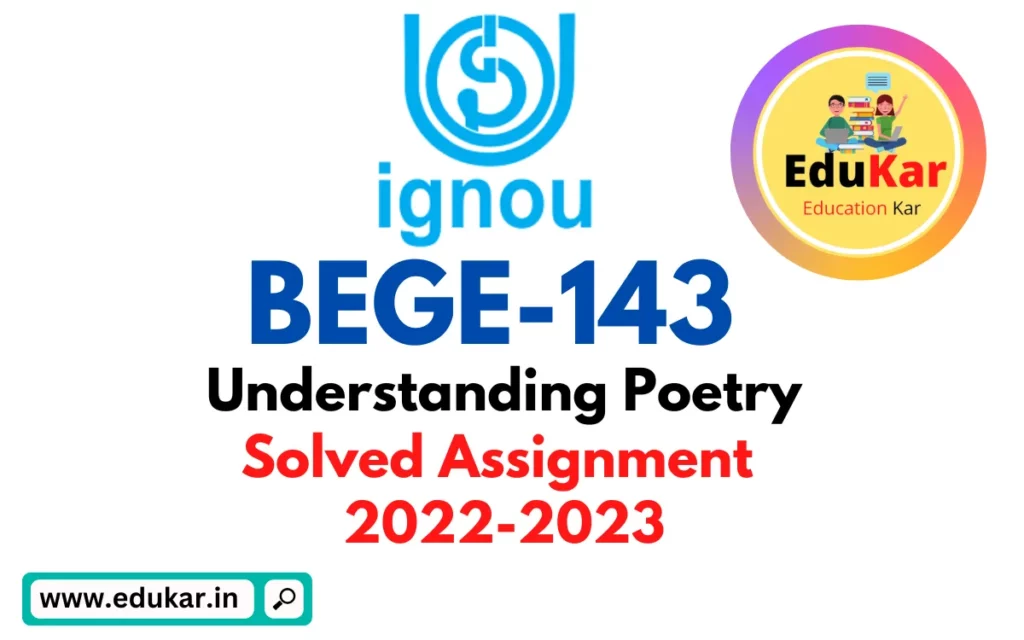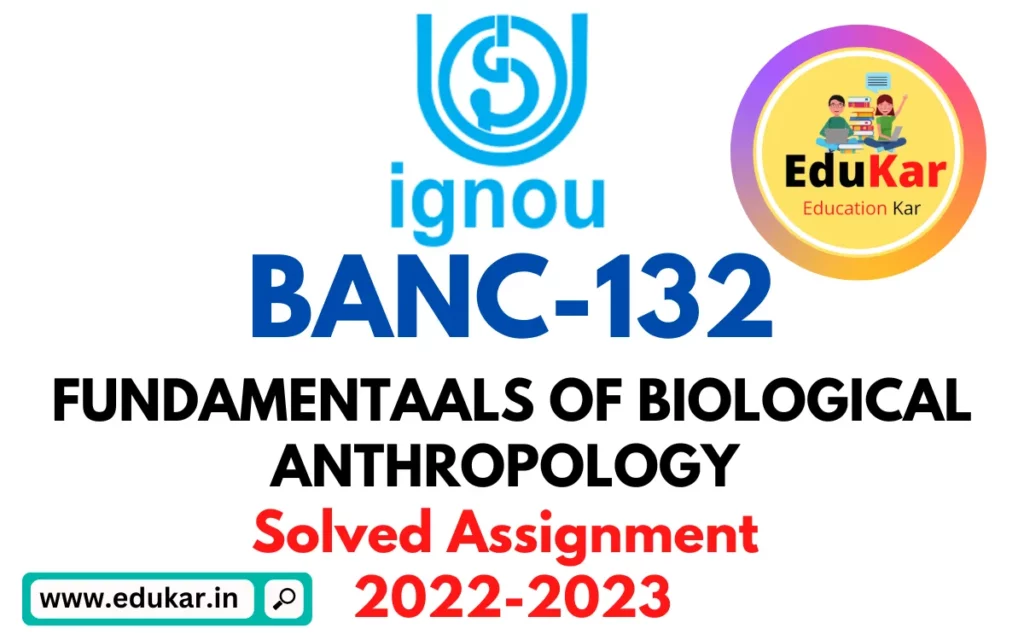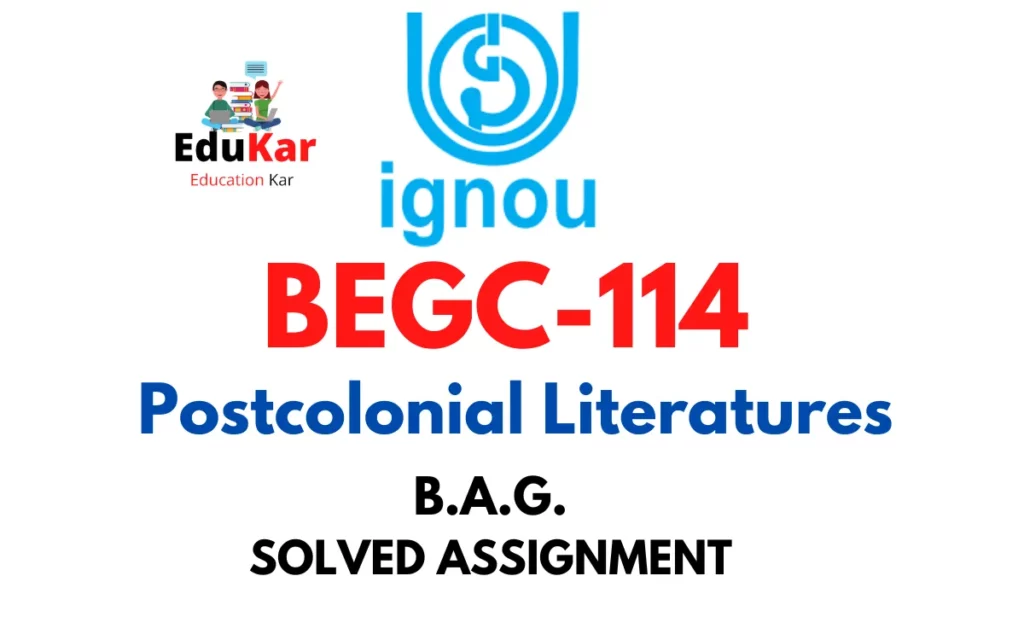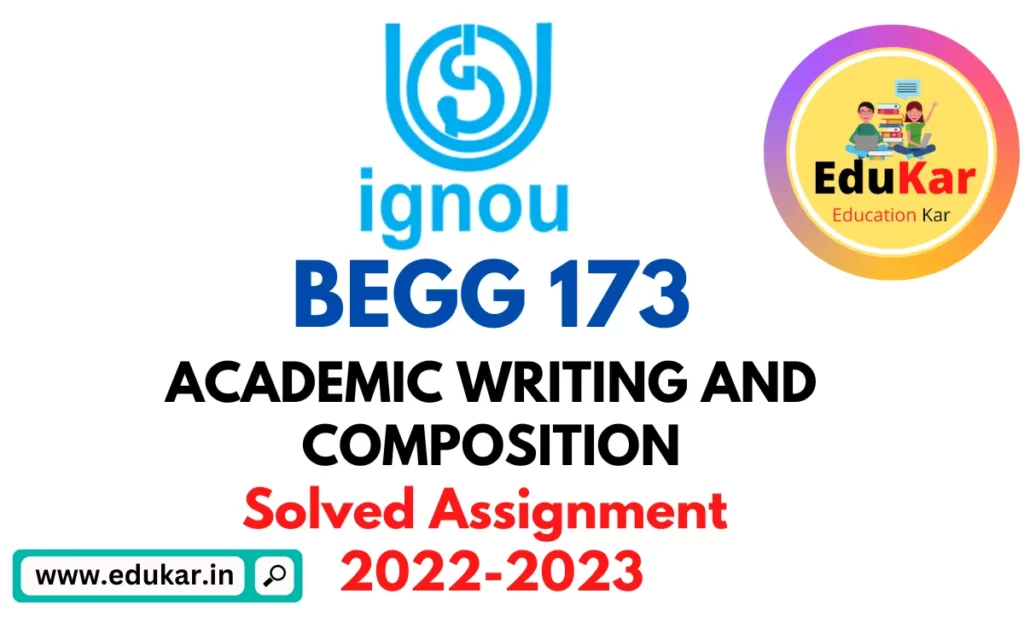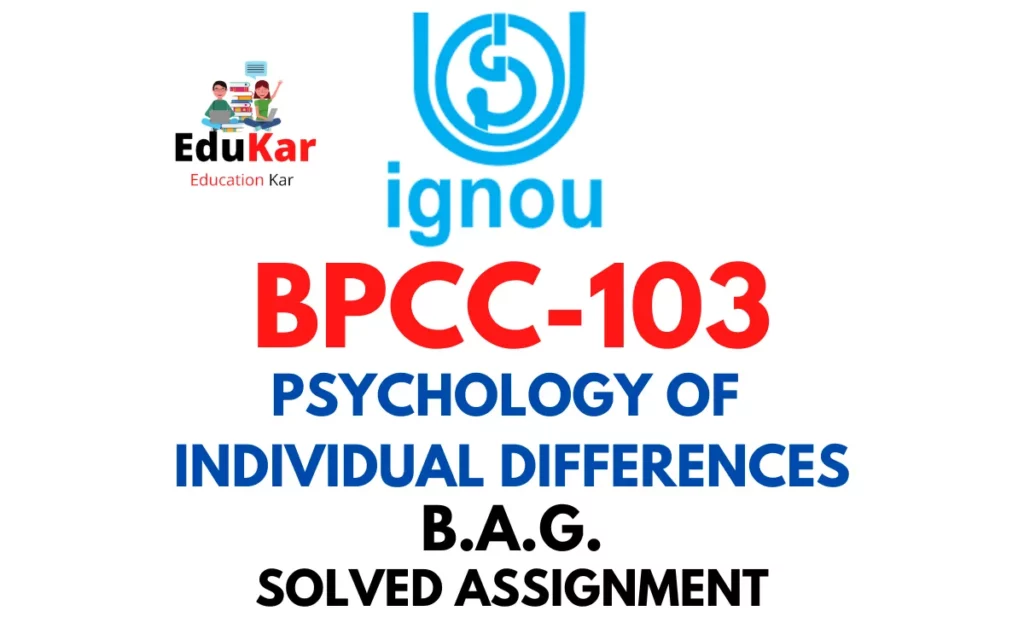Contents
- 1 Q.I Explain the reference to the context of the following:
- 2 (i) The new poets still quotedThe old poets, but no one spokeIn verseOf the pregnant womanDrowned, with perhaps twins in her,
- 3 (ii) Fed on God for yearsAll her feasts were monotonousFor the only dish was always GodAnd the rest mere condiments.
- 4 (iii) May the sins of your previous birthBe burned away tonight, they saidMay your suffering decreaseThe misfortunes of your next birth, they said
- 5 (iv) O Bird of Time, say where do you learnThe changing measures you sing?In blowing forests and breaking tidesIn the happy laughter of new made brides,
- 6 Q.II What is novel? Discuss its various aspects.
- 7 Q.III Analyze the story and title of A Tiger for Malgudi.
- 8 Q.IV Discuss the style and themes of the poems of Nissim Ezeikel with special reference to the poems prescribed in your course.
- 9 Q.V Critically analyze the story Swimming Lessons by Rohinton Mistry.

| Title | BEGC-103: IGNOU BAG Solved Assignment 2022-2023 |
| University | IGNOU |
| Degree | Bachelor Degree Programme |
| Course Code | BEGC-103 |
| Course Name | INDIAN WRITING IN ENGLISH |
| Programme Name | Bachelor of Arts (General) |
| Programme Code | BAG |
| Total Marks | 100 |
| Year | 2022-2023 |
| Language | English |
| Last Date for Submission of Assignment: | For June Examination: 31st April For December Examination: 30th September |
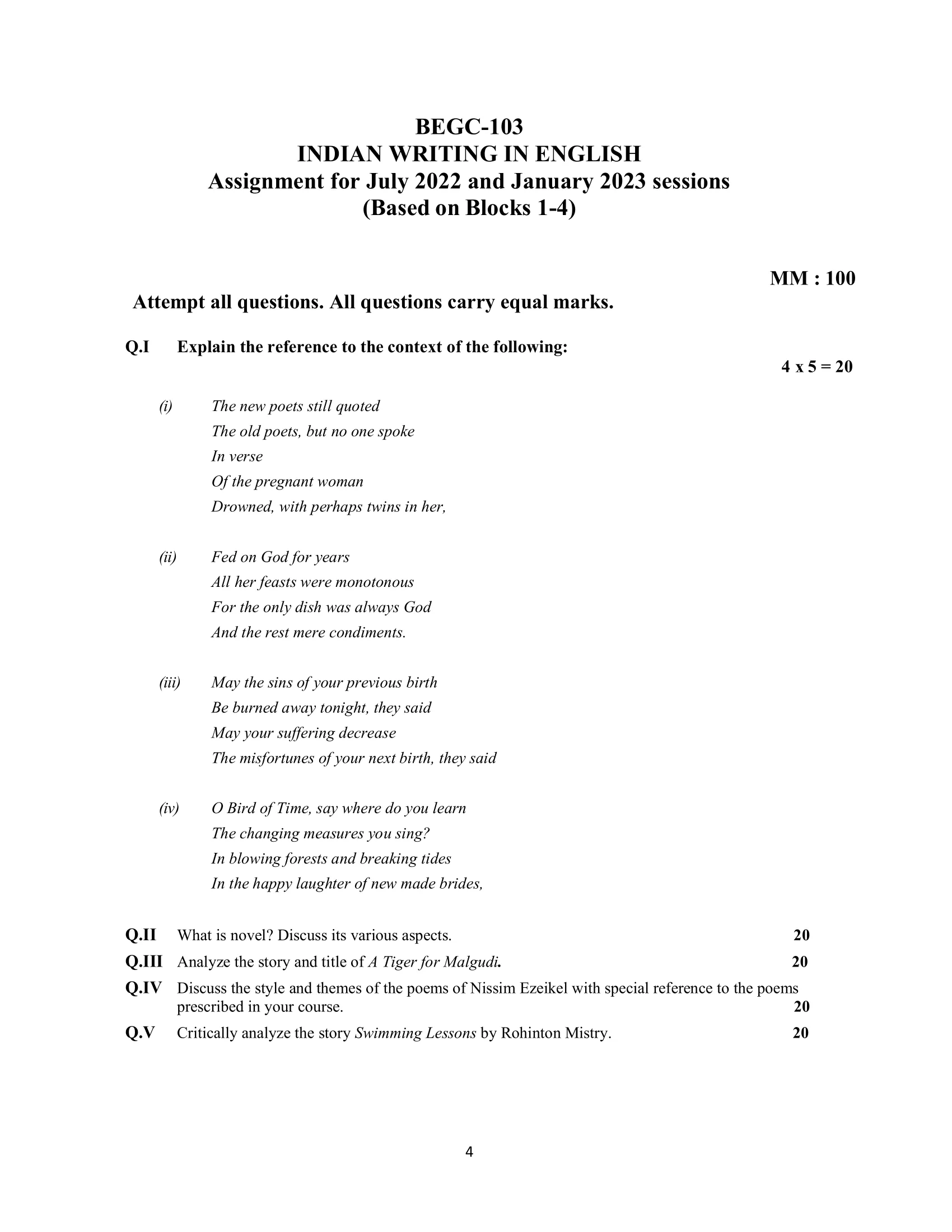
Q.I Explain the reference to the context of the following:
(i) The new poets still quoted
The old poets, but no one spoke
In verse
Of the pregnant woman
Drowned, with perhaps twins in her,
Ans: The reference to the context in this excerpt likely pertains to a discussion of poetry and its evolution over time. The first line suggests that there are “new poets” who are still drawing inspiration from “old poets,” indicating a continuation of tradition and influence from previous generations of poets.
However, the second line suggests that something has changed in the content or style of poetry being produced, as “no one spoke in verse of the pregnant woman drowned.” This line indicates that there is subject matter that is being left out or overlooked in contemporary poetry, namely the tragedy of a pregnant woman’s death and the possible loss of her unborn children.
The juxtaposition of the old and new poets in the first line and the absence of discussion of this tragic event in contemporary verse in the second line may be highlighting a disconnect between tradition and current concerns, or it may be suggesting that modern poetry is lacking in some way compared to the poetry of the past. Overall, the reference to context in this excerpt points to a discussion of the evolution of poetry and its relationship to the world around it.
(ii) Fed on God for years
All her feasts were monotonous
For the only dish was always God
And the rest mere condiments.
Ans: The reference to the context in this excerpt likely pertains to a discussion of religious devotion and the impact it has on a person’s life. The first line suggests that the subject of the passage has been deeply committed to their faith for a significant amount of time, as they have “fed on God for years.” This could indicate that they have relied on their religious beliefs as a primary source of sustenance or nourishment, both physical and spiritual.
The second line suggests that this devotion has had a monotonous quality to it. The phrase “her feasts were monotonous” could refer to religious observances that have become routine or repetitive, lacking in variety or stimulation. The final two lines of the excerpt use a metaphor to reinforce this idea, comparing the subject’s diet to a meal where “the only dish was always God” and everything else was “mere condiments.”
Taken together, the context of this passage may be exploring the consequences of an all-consuming religious devotion. It suggests that, while such devotion may sustain a person, it can also become predictable and limiting, leaving little room for other experiences or sources of meaning. The metaphor of food and nourishment emphasizes this point, suggesting that while a diet of faith may be sustaining, it can also lack variety and flavor, leading to a sense of sameness or even boredom over time.
(iii) May the sins of your previous birth
Be burned away tonight, they said
May your suffering decrease
The misfortunes of your next birth, they said
Ans: The reference to the context in this excerpt likely pertains to a religious or spiritual ritual, in which the speaker or subject is being offered prayers or blessings for the sake of their spiritual well-being. The first line suggests that the ritual or prayer is focused on purifying the subject of past sins or wrongdoings, as they are offered the hope that “the sins of your previous birth be burned away tonight.”
The second line offers a similar sentiment, but with a different focus. Here, the prayer or blessing is focused on reducing the subject’s suffering or misfortunes in their future lives. The line “may your suffering decrease” indicates that the subject is currently experiencing some form of hardship or difficulty, and that the prayer is intended to alleviate this in some way.
Taken together, the context of this passage suggests that the speaker or subject is engaged in some form of spiritual practice or belief system that emphasizes the importance of purification and karmic consequences. The idea of being freed from past sins and spared future suffering may be seen as a means of achieving a higher state of being or a greater sense of spiritual fulfillment.
(iv) O Bird of Time, say where do you learn
The changing measures you sing?
In blowing forests and breaking tides
In the happy laughter of new made brides,
Ans: The reference to the context in this excerpt likely pertains to the concept of time and the natural world. The first line addresses the “Bird of Time,” which could be interpreted as a metaphorical bird that represents the passage of time, or perhaps an actual bird that is symbolic of the natural cycles of life and death. The line poses a question to this bird, asking where it learns the “changing measures” that it sings, suggesting that time is a dynamic and constantly evolving force.
The second line describes two examples of the natural world that may be sources of inspiration for the Bird of Time. The “blowing forests” and “breaking tides” suggest the power and dynamism of nature, while the “happy laughter of new made brides” suggests the cyclical nature of human life, with weddings representing a new beginning and the start of a new phase of life.
Taken together, the context of this passage suggests a contemplation of the nature of time and its relationship to the natural world. The idea that the changing measures of time are learned from natural phenomena such as the wind, the ocean, and human cycles of life may suggest that time is a force that is intimately connected to the world around us. The use of poetic language and metaphor reinforces this sense of time as a mysterious and elusive force that is both beautiful and awe-inspiring.
Q.II What is novel? Discuss its various aspects.
Ans: The term “novel” can have several meanings, depending on the context in which it is used. In literature, a novel is a long piece of fictional prose, typically between 80,000 and 100,000 words, that tells a story through the actions, thoughts, and dialogue of its characters. Here are some aspects of the novel:
- Form and structure: Novels can be structured in various ways, depending on the author’s goals and the genre in which it falls. Some common structures include linear narrative, nonlinear narrative, and epistolary form. A linear narrative follows a chronological sequence of events, while a nonlinear narrative may jump back and forth in time. An epistolary novel is written in the form of letters, diary entries, or other documents.
- Themes and motifs: Novels can explore a wide range of themes, including love, loss, identity, power, and social justice. These themes may be expressed through recurring motifs, such as symbols or metaphors, that create a deeper meaning.
- Characterization: One of the primary features of a novel is its characters. A well-developed character can drive the plot and provide insight into the novel’s themes. Authors may use various techniques, such as direct or indirect characterization, to bring their characters to life.
- Style and language: The language and style of a novel can greatly affect the reader’s experience. An author’s choice of words, sentence structure, and literary devices can create a particular mood or tone, evoke emotion, or convey meaning.
- Genre: Novels can fall into various genres, such as romance, science fiction, mystery, or historical fiction. Each genre has its own conventions and expectations that the author can either follow or subvert.
In addition to these aspects, a novel can be evaluated based on its plot, pacing, setting, and point of view, among other factors. Ultimately, a novel is a complex and multifaceted work that can provide readers with hours of entertainment, insight, and reflection.
Q.III Analyze the story and title of A Tiger for Malgudi.
Ans: “A Tiger for Malgudi” is a novel by R.K. Narayan, a celebrated Indian writer, first published in 1983. The title of the book is straightforward and simple, but it encapsulates the central theme and plot of the story.
The story follows the life of a Royal Bengal Tiger named Raja, who is captured from the wild and brought to the fictional town of Malgudi, where he is put on display in a zoo. The zookeeper, Nataraj, becomes fascinated by Raja and becomes determined to give him a better life by releasing him back into the wild. The novel then chronicles Nataraj’s journey to set Raja free, as well as his growing attachment to the tiger.
The title “A Tiger for Malgudi” is significant because it emphasizes the central role that Raja, the tiger, plays in the story. The title also suggests the idea of possession, as if the tiger is an object that belongs to the town of Malgudi, which is a recurring theme in the novel. However, the title is also somewhat ironic since Raja is never really “for” Malgudi, but instead belongs in the wild. Thus, the title creates a tension between the tiger’s captivity and his ultimate freedom.
Furthermore, the title “A Tiger for Malgudi” also reflects the central theme of the novel, which is the relationship between humans and nature. The story explores the idea of ownership and control over the natural world, and how this relationship can be harmful to both humans and animals. Nataraj’s attempts to release Raja into the wild are a metaphor for the need to preserve and protect nature, rather than exploit it for human gain.
Q.IV Discuss the style and themes of the poems of Nissim Ezeikel with special reference to the poems prescribed in your course.
Ans: Nissim Ezekiel was one of the most significant Indian poets writing in English during the mid-20th century. His poems reflect a strong sense of cultural identity and social critique, while also demonstrating a wide range of literary techniques and styles. In this response, I will discuss the style and themes of some of his poems prescribed in various courses.
Style: Ezekiel’s poems are known for their simplicity of language, use of irony, and the integration of Indian ethos in English poetry. He often used everyday language and direct language to convey his message, with a strong focus on colloquialism and humor. In his poetry, he often employed imagery and metaphors drawn from Indian life and culture, and his use of free verse allowed him to experiment with form and structure.
Themes: Ezekiel’s poems are marked by a sense of irony, skepticism, and critique, often questioning societal norms and values. He was also interested in exploring the complex relationships between people, particularly those from different cultural and linguistic backgrounds. In his poem “The Patriot,” Ezekiel satirizes the idea of blind patriotism and points out the negative consequences of such nationalism. In “Night of the Scorpion,” he explores the concept of community and solidarity by depicting a village coming together in the face of a scorpion bite. His poem “Island” presents the complexity of the relationship between the colonizer and the colonized.
In the poem “Enterprise,” Ezekiel addresses the theme of modernization and its impact on Indian society. The poem satirizes the obsession with industrialization and the neglect of traditional agricultural practices, highlighting the negative consequences of progress. Similarly, “The Professor” critiques the educational system and the prioritization of academic knowledge over practical skills.
Q.V Critically analyze the story Swimming Lessons by Rohinton Mistry.
Ans: “Swimming Lessons” is a short story by Rohinton Mistry, a renowned Indian-Canadian writer, published in 1987. The story follows the journey of a young boy, Gustad Noble, who is sent for swimming lessons by his father, Major Jimmy Noble, during the summer of 1952 in Bombay. The story highlights the themes of societal expectations, class differences, and generational divides.
The story opens with the scene of Gustad’s father instructing him to attend swimming lessons with a private instructor, Mr. Mody. Gustad initially resists, but eventually agrees to attend the classes. Mody is a Parsi, and Gustad is a member of the working-class, highlighting the divide between the different classes in Bombay society. Gustad, as a member of the lower class, is in awe of Mody, who represents the upper class, educated elite.
As the story progresses, Gustad becomes increasingly disillusioned with Mody’s elitism and arrogance, particularly when Mody comments on Gustad’s weight and general physical appearance. Gustad’s resentment towards Mody deepens when he realizes that Mody’s so-called “swimming lessons” consist mainly of physical exercise rather than actual swimming instruction. In this sense, the story reveals the hypocrisy of the Parsi community, which, while espousing a Westernized lifestyle, also displays a disregard for physical fitness.
At the same time, the story also highlights the generational divide between Gustad and his father, Major Noble. The Major, as a member of the British Army, is deeply invested in maintaining a British colonial lifestyle, while Gustad is more interested in embracing Indian culture. The generational divide between father and son is exemplified by the fact that the Major does not understand why Gustad does not want to join the Scouts or play cricket.
How to Download BEGC-103 Solved Assignment?
You can download it from the www.edukar.in, they have a big database for all the IGNOU solved assignments.
Is the BEGC-103 Solved Assignment Free?
Yes this is absolutely free to download the solved assignment from www.edukar.in
What is the last submission date for BEGC-103 Solved Assignment?
For June Examination: 31st April, For December Examination: 30th October


